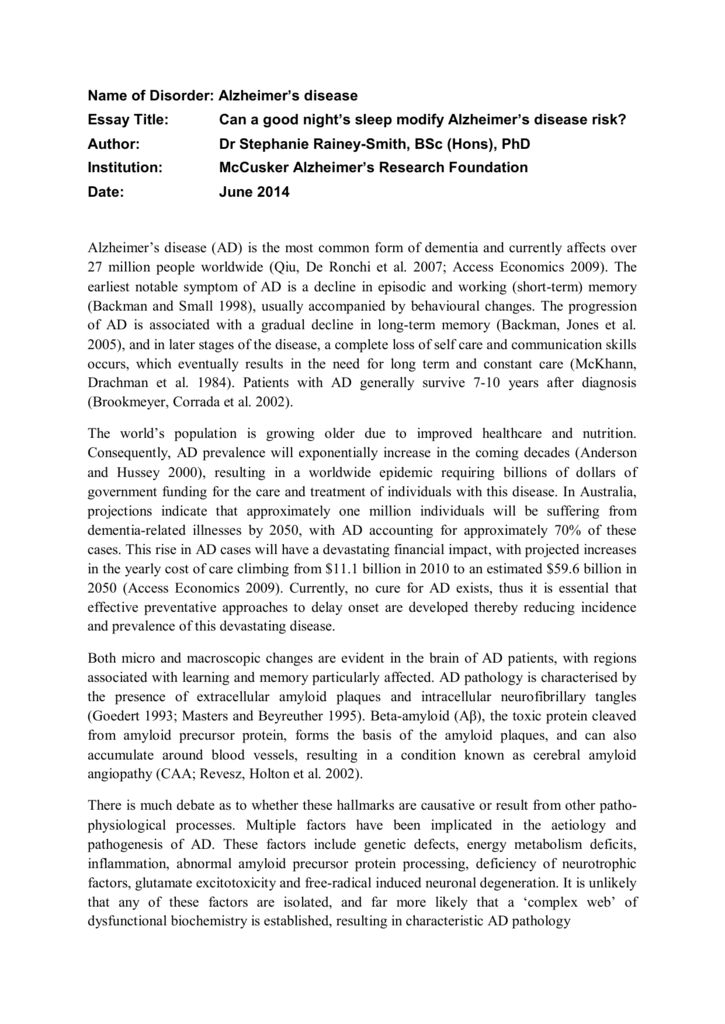
Jul 31, · Building upon the original diagnostic criteria, the National Institute on Aging–Alzheimer’s Association (NIA–AA) revised the clinical criteria for the diagnosis of mild cognitive impairment (MCI) and the different stages of dementia due to AD in 6– 8. The use of supportive biomarker evidence (imaging, serum, and CSF) of AD pathology were included Cited by: Aug 31, · Abstract. In this paper, Alzheimer’s disease will be delved into, investigated and dissected. This will include all that is known about the disease as much of it is unknown still, despite increasing efforts from the medical community to uncover its origin. The disease’s causes, symptoms and stages will be discussed and illuminated Feb 11, · Network modeling identifies molecular subtypes of Alzheimer’s: Using a large collection of human brain samples from different studies, a team led by researchers at Icahn School of Medicine also analyzed RNA sequencing data and identified three major molecular subtypes of Alzheimer’s. The subtypes, which are independent of age and disease stage, and
Alzheimer’s Disease: Past, Present, and Future
Alzheimer's Disease Biomarkers Dementias Neuroscience. AMP AD uses an open-science research model that makes all data and methods rapidly available to the research community at large through the data sharing infrastructure, the AD Knowledge Portal. Seven recent AMP AD reports showcase research advances related to the discovery of new drug candidate targets, identification of molecular subtypes of the disease, and new potential biomarkers that can serve as the basis for a precision medicine approach to therapy development.
Using network modeling, a way to show data and its relationships, the team identified large sets of genes associated with the disease. Their analyses identified ATP6VA1 as a master regulator gene of this neuronal network and demonstrated that increasing its expression genetically, or by using a pharmacologic agent, led to improving neuronal function in cultured alzheimers research papers and in flies.
These findings were published in Neuron and pave the way for new drug discovery efforts targeting ATP6VA1. The report of the discovery of this gene as alzheimers research papers key driver and its validation in mouse studies was published in Nature Communications.
This single cell profiling technology identified several molecular subtypes of microglia based on the pattern of gene expression. Follow-up validation studies in post mortem brain tissue showed that this microglia subtype was less abundant in Alzheimer's brains compared to control brains. This modeling method, called the manifold learning method, predicted early-stage disease processes, such as RNA-splicing, mitochondrial function, and protein transport.
These predictions speak to the complex nature of the disease and the need to verify these observations in longitudinal studies where alzheimers research papers signatures can be linked alzheimers research papers different clinical features of the disease. These findings were published in Nature Communications. The subtypes, which are independent of age and disease stage, and are replicated across multiple brain regions, show how different combinations of biological pathways lead to brain degeneration.
Their findings were published in Science Advances. These overlapping protein panels detected in the spinal fluid reflected changes in multiple biological process in the brain. These findings were published in Science Advances. The researchers reported that there are differences in a subset of blood metabolites associated with Alzheimer's based on sex and ApoE4 status.
ApoE4 is the strongest Alzheimer's risk factor gene. These metabolic changes suggest that females have a greater impairment of brain energy production than males.
The data and methods from the above alzheimers research papers are available and can be accessed by researchers across the world through the AD Knowledge Portal. The portal is the data repository for the AMP AD Target Discovery Program, and other NIA-supported team-science programs operating under open-science principles. Now in its sixth year, AMP AD is demonstrating the power of open science to enable the scientific community to investigate difficult scientific questions and jumpstart new drug discovery projects.
The AMP AD research teams are funded by NIA grants U01AG, U01AG, U01AG, U01AG, R01AG, R01AG, U19AG, U01AG, alzheimers research papers, U01AG, U01AG, U01AG, and U24AG The studies outlined here were also supported by the following NIA grants in order of appearance :. Wang M, et al. Transformative network modeling of multi-omics data reveals detailed circuits, key regulators, and potential therapeutics for Alzheimer's disease. Beckmann ND, et al, alzheimers research papers.
Multiscale causal networks identify VGF as a key regulator of Alzheimer's disease, alzheimers research papers. Nature Communications. Olah M, et al. Single cell RNA sequencing of human microglia uncovers a subset associated with Alzheimer's disease. Mukherjee S, alzheimers research papers, et al. Molecular estimation of neurodegeneration pseudotime in older alzheimers research papers. Neff RA, et al. Science Advances. doi: Higginbotham L, et al.
Integrated proteomics reveals brain-based cerebrospinal fluid biomarkers in asymptomatic and symptomatic Alzheimer's disease.
Arnold M, et al. Sex and APOE ε4 genotype modify the Alzheimer's disease serum metabolome.
Inside Alzheimer’s disease
, time: 4:20Dementia Essays: Examples, Topics, Titles, & Outlines

Oct 14, · The research paper looks at the two aspects and strives to contrast the two taking into account the biological, psychological, physiological as well as the sociological perspectives towards the two concepts. Normal ageing Alzheimer's disease is a type of dementia, of which there are many types Aug 31, · Abstract. In this paper, Alzheimer’s disease will be delved into, investigated and dissected. This will include all that is known about the disease as much of it is unknown still, despite increasing efforts from the medical community to uncover its origin. The disease’s causes, symptoms and stages will be discussed and illuminated Feb 11, · Network modeling identifies molecular subtypes of Alzheimer’s: Using a large collection of human brain samples from different studies, a team led by researchers at Icahn School of Medicine also analyzed RNA sequencing data and identified three major molecular subtypes of Alzheimer’s. The subtypes, which are independent of age and disease stage, and
No comments:
Post a Comment